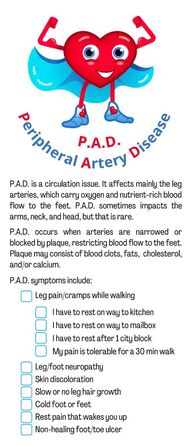
Return to flip book view
Why I Have P A D P A D Support Knowing what s lighting your arteries on fire can help you and your doctor take steps to slow or even stall progression of P A D This is the most important discussion you will have with your doctor High Cholesterol Diabetes Type I or II Genetics clotting MTHFR Sedentary Lifestyle Ask questions Learn new treatment options Find a P A D doctor Stress Anxiety Get a list of questions to ask your doctor Gut Issues bacteria Get diet help diet workbook Get help with transportation Join walking program get progress reports Excess Weight Heart Valve Issue Atrial Fibrilation AFib Autoimmune Condition Covid Other ______________________ Ask your doctor to perform advanced bloodwork and other testing to help pinpoint what s damaging your arteries and causing blockages Additional Bloodwork Testing Join our patient community You have arrived at a better quality of life with P A D CALL NOW 415 320 7138 TheWayToMyHeart org er P A D is al A rtery D ea ph ri High Blood Pressure No one should have to navigate this journey alone The Way To My Heart P A D Navigators are with you every step of your P A D journey to provide comprehensive education high touch advocacy and real time support Pe Diet se Nicotine P A D is a circulation issue It affects mainly the leg arteries which carry oxygen and nutrient rich blood flow to the feet P A D sometimes impacts the arms neck and head but that is rare P A D occurs when arteries are narrowed or blocked by plaque restricting blood flow to the feet Plaque may consist of blood clots fats cholesterol and or calcium P A D symptoms include Leg pain cramps while walking I have to rest on way to kitchen I have to rest on way to mailbox I have to rest after 1 city block My pain is tolerable for a 30 min walk Leg foot neuropathy Skin discoloration Slow or no leg hair growth Cold foot or feet Rest pain that wakes you up Non healing foot toe ulcer
P A D Diagnosis P A D Tests Ankle Brachial Index ABI A technician places blood pressure cuffs on your legs and arms during the ABI test They re comparing blood pressure between your upper and lower limbs to detect reduced blood flow An ABI test can result in a false negative if you have hardened calcified incompressible arteries Understanding Your Results Left _________ _________ _________ Right ________ _________ _________ 1 4 1 0 1 4 9 1 0 8 9 5 8 5 Severe calcium build up likely Normal No P A D Possible P A D starting Slight P A D Moderate P A D Severe P A D Arterial Duplex Ultrasound An arterial duplex ultrasound uses sound waves to create a color map of the arteries to identify areas of narrowing and or blockages The technician places a gel on your skin and runs a probe over it CT Angiogram This test combines a CT scan with an injection of a special dye through an IV to provide a clearer image of narrowed or blocked areas of your arteries My Areas of Narrowing Blockages Left Right Doctors place P A D patients into one of two categories based on test results and symptoms either claudication or critical limb ischemia CLI That category determines treatment options Claudication When you walk you experience symptoms that disappear at rest Most with P A D are considered claudicants and never require a procedure Lifestyle modifications and medical therapy are frontline treatment and can improve symptoms over time If the claudication doesn t improve over time and is lifestyle limiting meaning your daily tasks are impacted your physician may discuss a procedure Critical Limb Ischemia CLI CLI occurs due to a severe blockage that limits blood flow to your lower leg foot which can lead to tissue death Symptoms include leg pain numbness and cramping that wake you up at night Wounds may also appear on your feet toes that won t heal and or become infected and may result in gangrene Doctors will discuss minimally invasive or surgical options to try to restore blood flow Always get a second opinion if amputation is discussed Most are preventable with advanced tools and techniques P A D Classifications Treatment Intermittant Claudication Mild pain but doesn t stop you Moderate pain stops you at times Severe pain stops you often Lifestyle Limiting Claudication Severe pain interferes with daily tasks CLI Ischemic Rest Pain pain awakens you Non healing Foot Ulcer Gangrene Extensive Gangrene Tissue Loss Walking Diet changes Stop smoking Medication 3 month walking trial Do symptoms improve Angiogram Surgery P A D Treatment Frontline treatment for P A D is in your hands with lifestyle modifications If symptoms are lifestyle limiting a physician may intervene if they don t improve in 3 months with frontline therapy If in CLI lifestyle modifications are critical after blood flow is restored to slow or stall disease progression Walking It s the most effective treatment for P A D Your body has a collateral network of arteries that can expand and grow to re route blood flow around blockages My Walking Goal Diet Weight Loss Ask your doctor for a referral to a registered dietician to reduce artery damage caused by food such as unhealthy fats sugar and carbohydrates Clinician Name Appointment Smoking Cessation When your heart pumps blood into your lungs to fill it up with a fresh supply of oxygen chemicals in cigarettes flow directly into your bloodstream causing artery damage and blood clots It s important to quit smoking before a procedure as clots will stick to treated areas and cause blockages again Ask your doctor for help to quit smoking Suggestions Prescribed Medications Questions For My Doctor